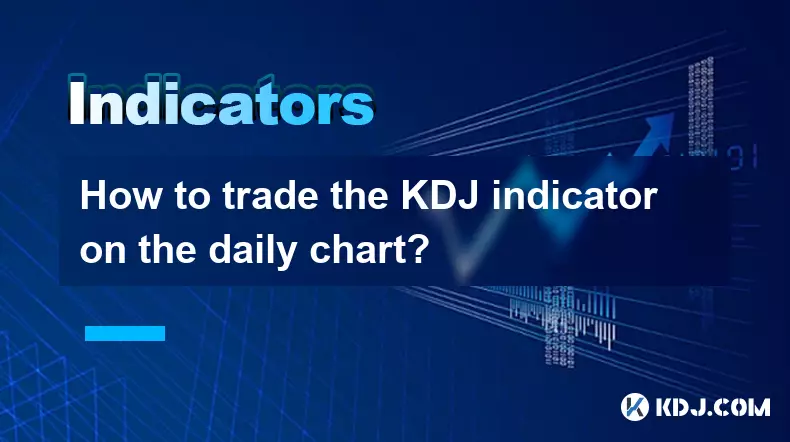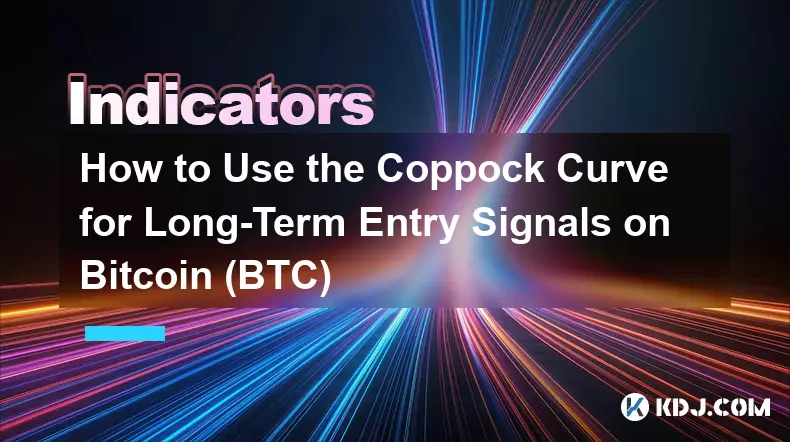-
 bitcoin
bitcoin $107015.826941 USD
-2.18% -
 ethereum
ethereum $3637.352324 USD
-5.18% -
 tether
tether $0.999831 USD
-0.02% -
 xrp
xrp $2.338078 USD
-6.23% -
 bnb
bnb $998.272150 USD
-6.97% -
 solana
solana $167.598257 USD
-10.12% -
 usd-coin
usd-coin $0.999863 USD
0.01% -
 tron
tron $0.282573 USD
-5.09% -
 dogecoin
dogecoin $0.169891 USD
-7.39% -
 cardano
cardano $0.557554 USD
-7.03% -
 hyperliquid
hyperliquid $39.914802 USD
-5.85% -
 chainlink
chainlink $15.414549 USD
-9.97% -
 bitcoin-cash
bitcoin-cash $510.361911 USD
-4.26% -
 ethena-usde
ethena-usde $0.999194 USD
-0.03% -
 stellar
stellar $0.282092 USD
-6.07%
How to trade the KDJ indicator on the daily chart?
The KDJ indicator helps crypto traders spot overbought/oversold conditions on daily charts, with K/D line crossovers and J-line spikes offering timely entry and exit signals when combined with volume, trend, and on-chain data.
Oct 19, 2025 at 06:36 am

Understanding the KDJ Indicator in Cryptocurrency Trading
1. The KDJ indicator is a momentum oscillator that combines elements of the Stochastic Oscillator with an additional signal line known as the J line. It consists of three components: K, D, and J lines. In the context of cryptocurrency trading, especially on daily charts, the KDJ helps traders identify potential overbought or oversold market conditions. Unlike faster timeframes, the daily chart provides a more stable reading, reducing false signals common in volatile crypto markets.
2. The K line represents the current momentum, calculated from the closing price relative to the price range over a set period, typically 9 days. The D line acts as a moving average of the K line, offering smoothed signals. The J line, derived from 3 times the K value minus 2 times the D value, reflects divergence and can spike sharply during strong trends. These dynamics are particularly useful when analyzing digital assets like Bitcoin or Ethereum, where sentiment shifts rapidly.
3. Traders use crossovers between the K and D lines to generate buy or sell signals. When the K line crosses above the D line in the oversold region (below 20), it may indicate a bullish reversal. Conversely, when the K line drops below the D line in the overbought zone (above 80), it suggests bearish momentum. However, due to the high volatility of cryptocurrencies, these levels should be used alongside volume analysis and trend confirmation tools.
Key Entry and Exit Strategies Using Daily KDJ
1. A common strategy involves waiting for both the K and D lines to rise from below 20, followed by a K-line crossover above the D line. This setup often precedes upward price movements in major coins. For example, after a prolonged downtrend in Solana, such a signal appeared on the daily chart, coinciding with institutional accumulation patterns observed on-chain.
2. To avoid premature entries during strong downtrends, traders should confirm the signal with support level breaks or increasing trading volume. If the KDJ exits the oversold zone while volume spikes, it strengthens the validity of the buy signal. Similarly, short positions are considered when the K line crosses below the D line above 80, especially if resistance levels align with historical price ceilings.
3. The J line’s behavior offers early warnings. When the J line exceeds 100, it indicates extreme bullishness, which might precede a pullback even if prices continue rising. On the flip side, a J line plunging below 0 signals panic selling, potentially marking capitulation points. Monitoring this line helps refine timing, especially before major news events or halvings.
4. Position sizing should reflect the strength of the KDJ signal. Weak crossovers near neutral zones (around 50) warrant smaller allocations, while deep oversold readings followed by clear crossovers justify larger exposure. Risk management remains essential, as sudden regulatory announcements or macroeconomic shocks can invalidate technical setups overnight.
Combining KDJ with Other Technical Tools
1. Integrating moving averages enhances reliability. For instance, only taking long signals when price is above the 200-day MA ensures alignment with the broader uptrend. This filter reduces losses during bear markets when KDJ generates frequent false positives.
2. RSI divergence combined with KDJ crossovers increases confidence. If RSI shows hidden bullish divergence while KDJ exits oversold territory, the likelihood of a sustained rally improves significantly. Altcoins like Cardano have exhibited such patterns ahead of multi-week rallies.
3. Fibonacci retracement levels serve as confluence zones. Entering longs when KDJ turns upward near a 61.8% retracement level adds precision. These areas often coincide with order book imbalances visible on depth charts, reinforcing the trade setup.
4. On-chain metrics such as exchange outflows or whale accumulation can validate KDJ signals. A bullish crossover supported by declining exchange reserves suggests smart money involvement, increasing the probability of success.
Frequently Asked Questions
What settings are optimal for KDJ on daily crypto charts?The default 9,3,3 parameters work well for most traders. Adjusting the smoothing periods may suit specific assets; for highly volatile altcoins, extending the lookback period to 14 can reduce noise.
Can KDJ be used during sideways markets?Yes, but with caution. In ranging markets, KDJ oscillates predictably between overbought and oversold levels. Traders can exploit these swings by fading extremes—selling near 80 and buying near 20—provided no breakout pattern is forming.
How does KDJ perform during major news events?Its effectiveness diminishes during sudden price gaps caused by news. The indicator lags because it relies on historical closes. Waiting for post-event stabilization ensures cleaner signals rather than reacting impulsively.
Is KDJ suitable for all cryptocurrencies?It performs best on large-cap tokens with consistent trading volume. Low-liquidity altcoins exhibit erratic price action that distorts KDJ readings, leading to unreliable crossovers and whipsaws.
Disclaimer:info@kdj.com
The information provided is not trading advice. kdj.com does not assume any responsibility for any investments made based on the information provided in this article. Cryptocurrencies are highly volatile and it is highly recommended that you invest with caution after thorough research!
If you believe that the content used on this website infringes your copyright, please contact us immediately (info@kdj.com) and we will delete it promptly.
- Ripple Competitor Alert: Is Remittix the Next Top 10 Crypto Challenger to XRP?
- 2025-11-04 20:10:02
- MEXC, USDf, and Trading Volume: A Deep Dive into Recent Developments
- 2025-11-04 19:15:01
- Meme Coins and Market Dynamics: Navigating the Crypto Landscape in Late 2025
- 2025-11-04 20:10:02
- Bitcoin, Crypto, and EcoYield Bonus: Is This the Smartest Play Now?
- 2025-11-04 19:15:12
- Cardano (ADA) and Altcoin Growth: Navigating the Landscape
- 2025-11-04 19:15:12
- Solana ETF, Institutional Battle, and Western Union: A New Era for Crypto?
- 2025-11-04 20:10:01
Related knowledge

Technical analysis for crypto: using RSI and MACD to find trading signals.
Nov 03,2025 at 03:18pm
Decentralized Exchanges Are Reshaping Trading Dynamics1. Decentralized exchanges (DEXs) have gained significant traction by eliminating intermediaries...

The Best Exponential Moving Average (EMA) Settings for Crypto Swing Trading
Oct 25,2025 at 04:55pm
The Best Exponential Moving Average (EMA) Settings for Crypto Swing TradingSwing trading in the cryptocurrency market relies heavily on identifying tr...

How to Use the Coppock Curve for Long-Term Entry Signals on Bitcoin (BTC)
Oct 31,2025 at 03:01pm
Understanding the Coppock Curve in Bitcoin Analysis1. The Coppock Curve is a momentum indicator originally designed for stock market indices but has f...

A Beginner's Guide to Finding Divergence with the MACD on the Solana (SOL) Chart
Oct 26,2025 at 12:36pm
Understanding MACD and Its Role in Solana Trading1. The Moving Average Convergence Divergence (MACD) is a momentum indicator widely used in cryptocurr...

How to Use the Aroon Indicator to Identify New Trends in Cardano (ADA)
Oct 26,2025 at 10:18pm
Understanding the Aroon Indicator in Cryptocurrency Trading1. The Aroon indicator is a technical analysis tool designed to identify whether an asset i...

Trading the Ichimoku Cloud "Kumo Twist" for Ethereum (ETH) Reversals
Oct 27,2025 at 01:54am
Understanding the Ichimoku Cloud and Its Components1. The Ichimoku Cloud, also known as Ichimoku Kinko Hyo, is a comprehensive technical analysis tool...

Technical analysis for crypto: using RSI and MACD to find trading signals.
Nov 03,2025 at 03:18pm
Decentralized Exchanges Are Reshaping Trading Dynamics1. Decentralized exchanges (DEXs) have gained significant traction by eliminating intermediaries...

The Best Exponential Moving Average (EMA) Settings for Crypto Swing Trading
Oct 25,2025 at 04:55pm
The Best Exponential Moving Average (EMA) Settings for Crypto Swing TradingSwing trading in the cryptocurrency market relies heavily on identifying tr...

How to Use the Coppock Curve for Long-Term Entry Signals on Bitcoin (BTC)
Oct 31,2025 at 03:01pm
Understanding the Coppock Curve in Bitcoin Analysis1. The Coppock Curve is a momentum indicator originally designed for stock market indices but has f...

A Beginner's Guide to Finding Divergence with the MACD on the Solana (SOL) Chart
Oct 26,2025 at 12:36pm
Understanding MACD and Its Role in Solana Trading1. The Moving Average Convergence Divergence (MACD) is a momentum indicator widely used in cryptocurr...

How to Use the Aroon Indicator to Identify New Trends in Cardano (ADA)
Oct 26,2025 at 10:18pm
Understanding the Aroon Indicator in Cryptocurrency Trading1. The Aroon indicator is a technical analysis tool designed to identify whether an asset i...

Trading the Ichimoku Cloud "Kumo Twist" for Ethereum (ETH) Reversals
Oct 27,2025 at 01:54am
Understanding the Ichimoku Cloud and Its Components1. The Ichimoku Cloud, also known as Ichimoku Kinko Hyo, is a comprehensive technical analysis tool...
See all articles










































































